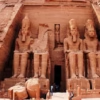Introduction
Egypt is renowned not only for its pyramids and the Nile, but also for its unique desert landscapes. Among the most fascinating are the White Desert (“El-Sahara el-Beida”) and the Black Desert (“El-Sahara el-Soda”). Located in the country’s western region, these areas feature surreal rock formations, geological wonders, and an almost otherworldly atmosphere. This article explores their formation, distinctive features, and significance for tourism.

1. The White Desert – A Limestone Fairytale
1.1 Location & Access
Located approximately 500 km southwest of Cairo near Farafra, the White Desert is part of the White Desert National Park and a popular destination for desert safaris.
1.2 Geology & Landscape
The desert’s name derives from its chalk-white rock formations, shaped by wind and sand erosion. Millions of years ago, the area was submerged under a sea, leaving behind limestone and chalk deposits. Today, visitors can see:
- Mushroom rocks (formed by harder rock layers at the top)
- Surreal sculptures (e.g., “Chicken Rock” or “The Mushroom”)
- Vast, glowing-white plains that appear magical under moonlight
1.3 Flora & Fauna
Despite the arid climate, the desert supports:
- Fennec foxes
- Desert jerboas
- Rare desert plants like acacias
1.4 Tourism
- Overnight camping under the stars (especially during full moon)
- Photography (dramatic sunrises and sunsets)
- Adventure tours with 4×4 vehicles

2. The Black Desert – Volcanic Forces
2.1 Location & Access
Situated north of the White Desert near the Bahariyya Oasis.
2.2 Geology & Landscape
Its dark appearance results from volcanic activity:
- Black basalt covering golden sand
- Impact craters and fossilized lava flows
- Djebel el-Engleez Mountain (an eroded volcano)
2.3 Unique Features
- Fossil discoveries (e.g., petrified corals)
- Striking color contrasts (black stones on golden dunes)
2.4 Tourism
- Scenic viewpoints like English Mountain
- A hotspot for geologists
3. Comparing the Two Deserts
| Feature | White Desert | Black Desert |
|---|---|---|
| Color | White (limestone) | Black (basalt) |
| Formation | Marine deposits | Volcanic activity |
| Atmosphere | Surreal, mystical | Smoky, primordial |
| Activities | Camping, photography | Hiking, fossil hunting |
4. Importance for Ecotourism
Both deserts are UNESCO-protected and attract nature enthusiasts. Key considerations:
- Sustainable tours (leave no trace)
- Support local guides (e.g., Bedouins from Bahariyya)
Conclusion
Egypt’s White and Black Deserts are natural wonders that showcase the diversity of desert landscapes. While the White Desert resembles a moonscape, the Black Desert evokes a post-apocalyptic scene. Both are must-visit destinations for travelers seeking Egypt’s authentic beauty beyond typical tourist paths.





